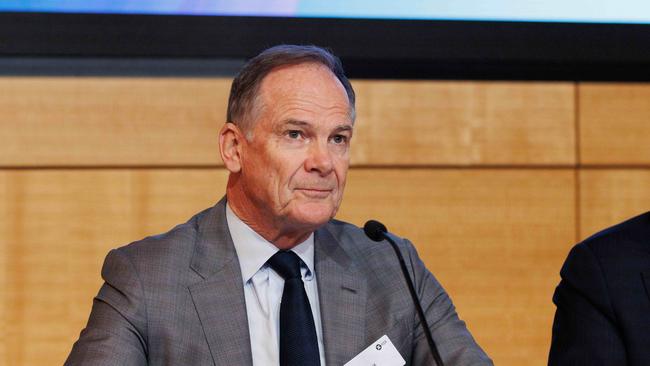
Well before Donald Trump became US President, leading American companies had discovered their diversity-based appointment quotas were looming as a potential danger, as they adapted their enterprises to the new era of computer enhancement and artificial intelligence.
So, when Trump pressed the merit-based management starter’s gun, a series of major US companies were ready to impose this “revolutionary new management system” on to their operations and boards.
The merit system would also be suggested to their suppliers.
The world’s largest retailer, Walmart, was first out of the blocks but McDonald’s, Ford, Harley-Davidson and Lowe’s quickly jumped on the bandwagon.
Incredibly, holding Australia back from following the US on merit-based appointments are the ASX corporate governance council and the superannuation industry bodies.
The ASX wants S&P/ASX300 companies to have a measurable objective for gender diversity on boards. The say a gender balanced board should contain at least 40 per cent women; at least 40 per cent men and up to 20 per cent any gender.
In the last decade Australian boards and top management have been greatly enhanced by the contribution of women and people of different cultures.
In a properly instituted merit system there will, and should be, diversity. But, imposing it by quotas not only downgrades those who take up appointments but can lead to boards and top management groups with the wrong people in key positions.
Companies which embrace a proper 2025-style merit-based appointment policy will make sure the best person gets the job, irrespective of their gender, colour or any other characteristic.
That’s very different to the way appointments were made, say, 10 years ago with females, gays and race often used as a discrimination tool.
A proper merit-based appointment system will normally deliver diversity. And it may be that diversity is actually essential for a particular company and its importance ranks with merit. But that’s a decision for an individual company, not an ASX policy.
The combination of ASX and superannuation funds focus on diversity is causing the ALP to look hard at legislating to require diversity board quotas for corporations dealing with the government. Presumably, American companies would be exempt, giving them a huge advantage over the locals.
The ASX is currently facing its biggest challenge since the bank nationalisation issue in 1949.
The government has a signature tax policy to tax unrealised gains in parts of the superannuation movement and this tax will spread rapidly through members of superannuation funds who are the biggest holders of Australian shares.

Even more dangerous would be an ALP/Greens government, which the opinion polls say is likely, and which almost certainly involves the Greens extending the ALP’s tax on unrealised gains deeper into superannuation, and then outside of superannuation into rich people.
Both the ALP government and the Greens have promoted unrealised gains taxes (under a smokescreen of more acceptable taxes), showing it is a core objective. It will be a major election issue and could devastate stockmarkets long-term.
Where is the ASX? It’s concentrating on gender — and related — issues
The fact the government and an influential minority party would have policies which impact the profitability and capital formation of the nation shows the role of profits in generating expansion and employment growth is not understood in the community. The ASX is missing in action.
Companies are increasingly not wanting to join the ASX because the regulations and red tape — often imposed by government bodies — make listing a nightmare experience.
Australian companies should continue diversity strategies if it makes sense for their business, but it is clearly irresponsible for the ASX to impose such strategies on Australian companies at a time of a new computer-based revolution, and when America is moving the other way.
Meanwhile, the superannuation funds are using the diversity strategy to paper over serious shortcomings in their board structures.
Most industry superannuation funds structured their boards around representation from union and employer groups. The system worked well when they were smaller and a small group of talented people was supervising activities.
Said group included: former Victorian Premier Steve Bracks; former IFM group chief Garry Weaven; former ACTU boss Greg Combet, and the former head of Australian Super Ian Silk.
This unique group quickly fixed up many problems encountered by the industry superannuation funds. The industry funds boomed but Bracks, Weaven, Combet and Silk have retired or moved on.
The deficiencies in many of the industry fund boards was shown when they have lost control of the distribution of money to beneficiaries. And they don’t understand the environment for young members has changed.
When Paul Keating started mass superannuation, buying a dwelling was easy for most young people. Now, it’s tough. Yet, dwellings are the best retirement base.
Superannuation funds can adapt to this new environment, but this will require boards who understand what is happening in 2025.
Industry funds desperately need people with great talents to tackle the money distribution mess and restore superannuation investment as a valued tool for younger people as members adapt to the current conditions and prepare for retirement down the track.
There would be a legitimate argument suggesting an essential part of board appointments in a superannuation fund is gender diversity, given the changed nature of its business.
But, that doesn’t mean it should be a virtual blanket benchmark for the top 300 listed companies.
And remember, every one of those top ASX 300 companies will face unique challenges as this new industrial revolution takes hold.
They must find people to help them adapt, and if those people create diversity then that’s great. But the starting point must be merit.





